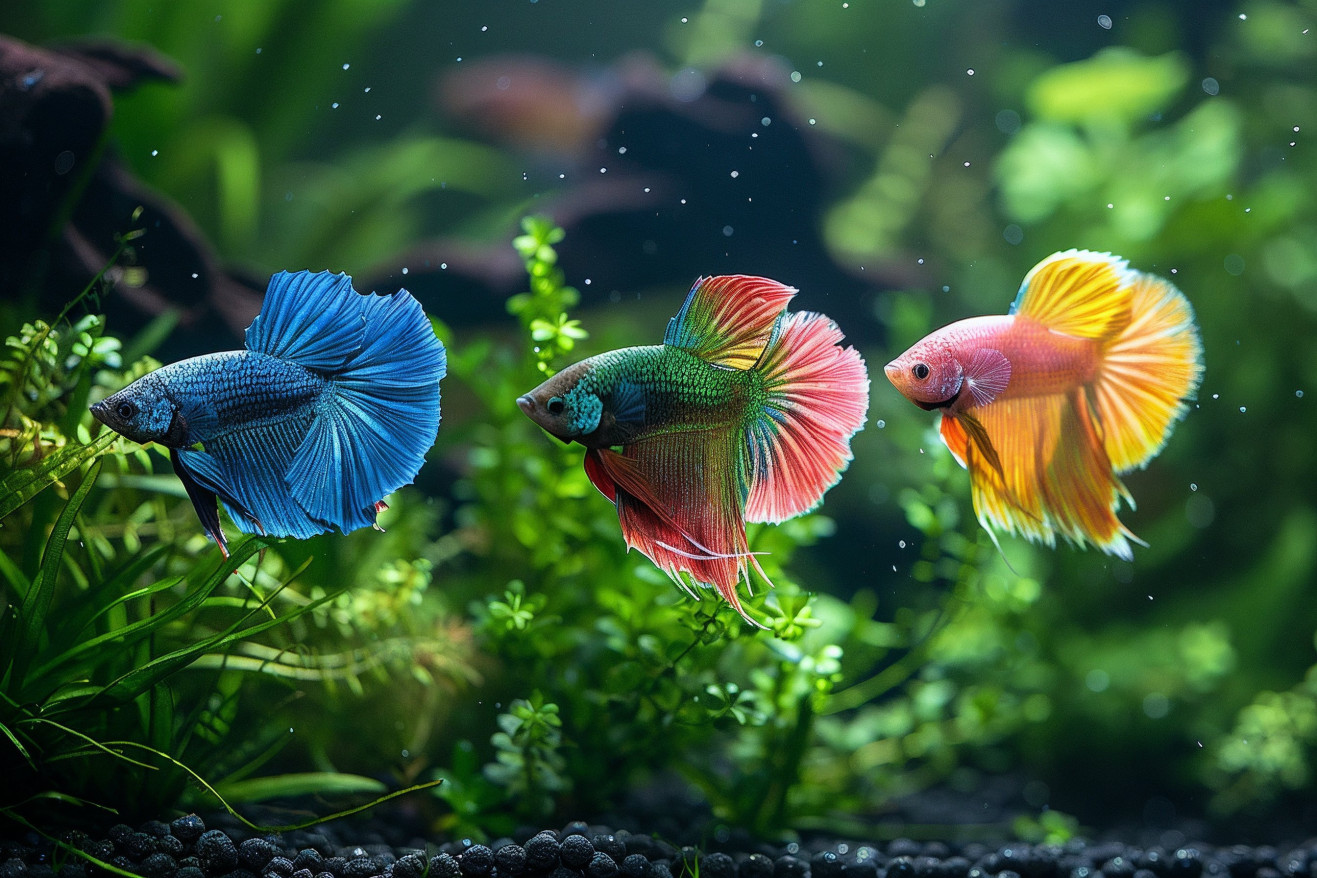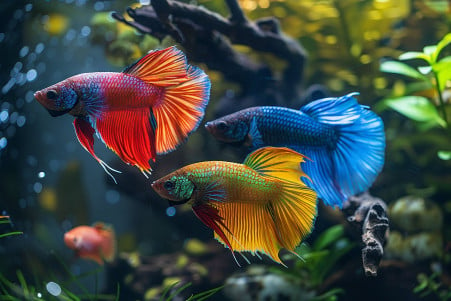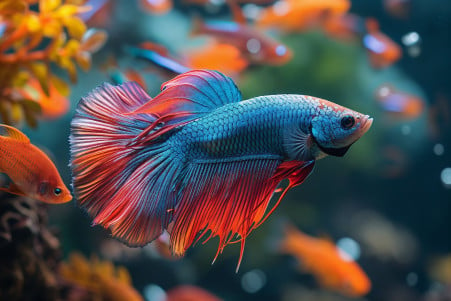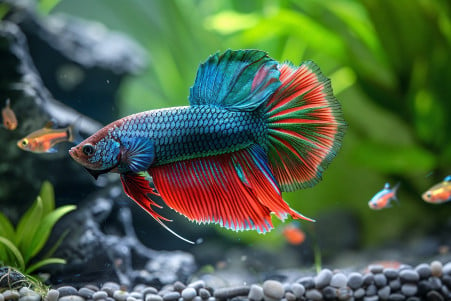How Many Female Bettas in a 10 Gallon Tank? A Complete Guide
5 June 2024 • Updated 4 June 2024

If you want to keep a sorority of female betta fish, you'll need to make sure you have the right tank and the right setup. So how many female bettas can you keep in a 10 gallon tank? You can keep 4-6 female betta fish, also known as betta splendens or Siamese fighting fish, in a 10 gallon tank. Female bettas are less aggressive than males, but you'll still want to make sure they have plenty of room to swim, as well as hiding places and line-of-sight breaks to help prevent territorial behavior. You'll also need to make sure you have the right tank mates, plants, and caves.
In this article, we'll look at both scientific studies and advice from experienced fishkeepers to help you set up a 10 gallon community tank for female bettas. We'll cover everything from the size of the tank to the water parameters, stocking levels, decor, maintenance, and more to help you keep this popular labyrinth fish in a peaceful sorority. This will help you create a healthy, beautiful underwater world for these colorful, interesting freshwater fish.
How many female bettas can be kept in a 10 gallon tank?
Tank Size and Dimensions for Betta Sororities
According to Coast Gem USA, a minimum of a 10-gallon tank is needed for a betta sorority. However, larger tanks, such as 15-20 gallons, are better because they provide more swimming room and help keep water parameters stable. FishLore suggests getting a tank that is longer than it is tall to accommodate the betta's natural tendency to swim at the top of the water. This is because the right dimensions will mimic the shallow, vegetated waters that these labyrinth fish are used to in the wild.
Other things to consider when determining the best tank size for a betta sorority include the bioload from waste and the number of other fish in the tank. According to Aquariadise, if you have more than five females in a 10-gallon tank, the tank will be overcrowded. To make sure that there is enough space to reduce territorial behavior, it's best to have 2-3 gallons per betta. Having a larger tank will also make it easier to add more fish if the sorority works out. If you set up the tank properly, you can have a successful community that meets the needs of these special fish.
Setting Up the Perfect Sorority Tank
According to FishLore, heavily planted tanks with lots of hiding spaces are a must when it comes to setting up a betta sorority. Good plant options include swords, java ferns, and anubias, all of which not only give the bettas places to hide but also help keep the tank clean by controlling algae. Other decorations, like betta logs, caves, and line-of-sight breaks, will help make the tank a more natural and less stressful place for the fish.
Of course, it's also important to make sure that the water in the tank is properly maintained. According to Modest Fish, the water temperature should be kept between 75°-81°F, and the pH should be between 6.5-7.5. Regular water changes of 25-50% every week, as well as substrate vacuuming, will help make sure that the tank stays clean and the water stays healthy for the fish.
In addition, it may be helpful to have an odd number of bettas in the sorority, like 5 or 7, to ensure that the hierarchy is more stable, as suggested by Tropicflow. This will make sure that the social structure is more defined and that there's less chance of ongoing conflict between the females.
How to Add New Members to a Betta Sorority
According to MonsterFishKeepers.com, the best way to add new members to a betta sorority is to select healthy, similarly sized females from a reputable local breeder or store. Tropicflow also recommends that you choose younger, less aggressive females for the best chance of success. It's also important to quarantine and acclimate new members properly.
Watch the tank closely after adding new members for signs of aggression or bullying, as explained on the Betta Fish Forum. You may need to separate the most aggressive or bullied fish temporarily to keep the peace in the sorority. However, if you follow these guidelines, you should be able to grow your betta sorority successfully.
Keeping Male Bettas in Community Tanks
While this article has focused primarily on keeping female bettas in sorority tanks, it's also important to talk about the care of male bettas in community tank situations. According to PetMD, male bettas should be kept alone or in community tanks of at least 10 gallons with other non-aggressive, peaceful fish. Some good options include tetras, corydoras catfish, and other small, peaceful fish.
It's important to make sure that there are plenty of hiding places and breaks in the line of sight to help reduce stress for male bettas, as suggested by Petco. Male bettas should not be kept with other male bettas or other long-finned fish that are brightly colored and could be seen as a threat. In addition, it's important to make sure that the water quality is good, that the fish are being fed a varied diet, and that the tank is being properly maintained to ensure the health and happiness of male bettas in a community tank.
By learning about the needs and behaviors of male bettas, aquarists can create a healthy community tank that meets the needs of these colorful, charismatic freshwater fish. Keeping an eye out for signs of stress and disease can help make sure that a betta community thrives in the long term.
How to Spot Stress and Disease in Bettas
Healthy bettas are characterized by bright colors, long fins, and an active, alert nature, per Tropicflow. On the other hand, bettas that are stressed may have clamped fins, faded colors, a lack of appetite, and swim erratically, according to this Quora response.
Bettas can experience stress from a variety of sources, including poor water conditions, tank mates, and strong water currents, according to USBetta. This is why it's important to be on the lookout for these signs of stress or disease so you can address any problems before they get worse.
If your betta has a severe or unknown condition, wikiHow suggests taking your betta to an exotic fish vet, who can provide an accurate diagnosis and prescribe the right medications. By keeping an eye out for potential issues and responding quickly, you can make sure your betta stays healthy and happy for years to come.
Conclusion: How to Set Up a Successful Betta Community
Setting up a successful betta sorority or community tank requires careful planning and attention to detail. Factors to consider include tank size, the number of hiding places, and water quality. In addition, it’s important to consider the importance of quarantine and the proper introduction of new fish to an established group.
While female bettas can live together in a sorority, male bettas have different housing needs and should be kept either alone or with peaceful community fish. It’s important to monitor all bettas for signs of stress and disease to ensure their long-term health and happiness.
By following best practices and providing a supportive environment, fishkeepers can set up a betta community that allows the fish’s vibrant colors and engaging personalities to shine. With the right care and attention, the benefits of a successful betta tank are well worth the effort.


